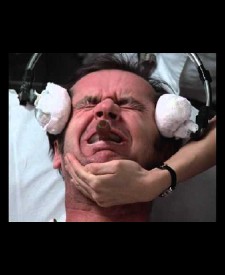 “60 Minutes” ran a segment last Sunday on electroconvulsive therapy (ECT), better known as shock treatment. Kitty Dukakis was interviewed as a long-time recipient and advocate of ECT for her severe depression. The piece was almost entirely positive, save for brief mention of memory loss as an unfortunate side-effect. This was soon left behind by video of a treated, newly smiling patient declaring no such problem: new technologies are in development, e.g., magnetic shock therapy or MST, that promise to mitigate this issue. ECT was presented as an under appreciated miracle treatment — and miracle treatments, unfortunately, always make me worry.
“60 Minutes” ran a segment last Sunday on electroconvulsive therapy (ECT), better known as shock treatment. Kitty Dukakis was interviewed as a long-time recipient and advocate of ECT for her severe depression. The piece was almost entirely positive, save for brief mention of memory loss as an unfortunate side-effect. This was soon left behind by video of a treated, newly smiling patient declaring no such problem: new technologies are in development, e.g., magnetic shock therapy or MST, that promise to mitigate this issue. ECT was presented as an under appreciated miracle treatment — and miracle treatments, unfortunately, always make me worry.
In addition to reassuring the public — ECT isn’t painful and doesn’t feel punitive anymore, in contrast to its fictional depiction 43 years ago in “One Flew Over the Cuckoo’s Nest” — the segment also admonished psychiatrists who don’t use ECT often enough. According to “60 Minutes,” severely depressed patients are languishing for years on ineffective antidepressants, imprisoned by their doctors’ outdated prejudices and unfounded fears.
Like so much in the news these days, this report oversimplified to make a rhetorical point. The reality is rather different. I can only recall two patients in my decades-long practice who possibly would have benefitted from ECT. (I’m not trained to administer it, so they would have been referred to a colleague.) All the other depressed folks I’ve seen, hundreds of them, improved on psychotherapy, standard antidepressant medicine, or both. Or they had longstanding personality issues that made them depressed — a vexing problem to be sure, but not one ECT can fix. The great majority were eventually helped by more benign and far less expensive treatment than ECT.
This is not surprising considering that most depression is of modest severity. And the modest severity of most depression is itself not surprising. In an effort to capture as many cases as possible, the DSM-5 diagnostic criteria for major depressive disorder includes chronically unhappy people who are still able to work or attend school, people with no psychomotor slowing, and people who have never given suicide a serious thought. While severe melancholic depression looks and acts very much like a disease worthy of a medical intervention under general anesthesia, i.e., ECT, most of what we call depression these days does not. A great many people hobble along, not really enjoying life but not being severely impaired either. Suggesting ECT for this group is irresponsible.
The perceptions and history of ECT remain roadblocks as well. Even voluntary ECT is the epitome of paternalistic medicine: a powerful, technological treatment done to a passive patient. And while most ECT is now voluntary and requested, historically it wasn’t. Some ECT in the U.S. is still court-ordered today. This again follows from its use in the most severely depressed patients, who may exhibit nihilistic delusions, or are so impaired they can’t participate in their own treatment. Even if it is highly effective and without better alternatives, restraining someone in order to administer anesthesia and an electric shock that causes a grand mal seizure is a tough notion for the public to accept.
Feel-good pieces on television are no match for the discomfort most of the public feels about shock treatment. I would not hesitate to recommend it for severely depressed, non-functional patients, especially those with classic melancholic depression who have failed full trials of standard antidepressant medication. Also, ECT may be a good first choice when depression is accompanied by mood-congruent delusions. But these are unusual conditions where the established efficacy of ECT outweighs its attendant memory loss, cost, and apprehension. Realistically, we ought to think of ECT as we do life-saving surgery: an essential option when needed, but hardly something to be popularized or welcomed lightly.

Dr Reidbord
You talk about magnetic shock therapy (MST). Not sure if that is the same as Transcranial Magnetic Stimulation that I received over the course of several weeks at a cost of$10,000 out of pocket because it was not paid for by insurance. I received it for Major Depression though I have received many diagnoses. The procedure did not work and just made me more anxious
MST is still experimental: a way of inducing a seizure (as ECT does) using magnetism instead of electric current. In contrast, TMS is in clinical use, and does not result in seizure. They are quite different. While TMS helps many with depression, it doesn’t help everyone, and as you mentioned, it’s quite expensive.
Patients who “receive many diagnoses” tend to have less success with any given treatment. This is partly a statistical artifact: if early treatments worked, the patient would not still be seeing doctors and receiving new diagnoses. But it’s also partly because multiple diagnoses are given to patients whose conditions do not fit the usual patterns. And treatments like TMS have been designed and tested on the typical disorder, not unusual variants (or problems we don’t quite have names for). I’m sorry TMS didn’t help you. Thanks for writing.